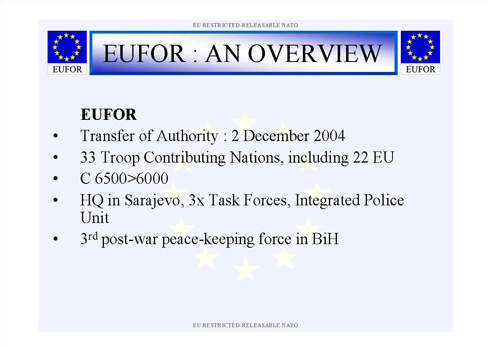European Union Force
- European Union Military Staff
- 6 pages
- EU Restricted
- Releasable NATO
- November 30, 2005
EUFOR
• Transfer of Authority: 2. Dezember 2004
• 33 Troop Contributing Nations, including 22 EU –
• C 6500> 6000
• HQ in Sarajewo, 3x Task Forces, Integrated Police Unit
• 3rd post-war peace-keeping force in BiHEDST
•Completes EU family/toolkit. Crisis Management /technical assistance.
•Second ESDP mission in BiH. Third military mission worldwide
•General concept: global engagement, comprehensive approach, coherence and unity of effort
•EUFOR engagement with other players: EUSR/OHR, EUPM, EUMM, CAFAO, Commission and Embassies
•Solana: new, different and distinctDifferences
• KMT to Support OHR’s MIP
• KST to support the fight against organised crime
• Directly tied to OHR in way SFOR was not; also directly tied to EUSR through EU coordinating mechanismsRelations with NATO
• Took over from SFOR
• Berlin + : chain of command, HQ, communications etc
• Similar tasks: Defence Reform, PIFWCs, CT
• But separate missions, separate mandates, coordination where overlap
• EUFOR is mandated peace-keeping force: Dayton and Chapter 7Tasks, operations and activities: visibility, credibility and robustness
• SASE, deterrence, reassurance: harvests, Stable Door, Sunburn
• Dayton compliance: inspection of weapons and ammunition storage sites, control of military movements etc
• Support for MIP and ICTY; Spring Cleans and individual operations; embolden local authorities; pressure on criminal and PIFWC networks; help change attitudesMilitary assessment: Potential causes of Instability
• Dominance and divisiveness of mono-ethnic politics
• Fragile economy and low FDI
• Regional Situation
• Weapons
• OCC: obstacle to progress towards self-sustainability and EU
• Overall: risks to security low; but EUFOR necessary security blanket and facilitator to progress in right directionPolitical Assessment and Developments
• SAA negotiations, 25 November: police restructuring
• Defence Reform and PfP
• ICTY cooperation
• Capacity building: development of fledgling state institutions
• Dayton dysfunctionality: nationalism: 2006 elections
• Search for functionality: USIP, Brussels and Washington• Insurance policy, allowing adjustments elsewhere
• LOTs: outreach: increasingly important as others draw down
• Directly affected by police and defence reform
• EUFOR as a test bed: subject of internal and external scrutinyEUFOR Sucesses
• Seamless transition from SFOR- also a tribute to NATO
• Fulfillment of main tasks: reassurance and deterrence
• Proof that Berlin+ works on the ground
• Early demonstration of robust presence; publicity and Stable Door
• Winning supportive press and public
• Close relations with local authorities: Terzic, Radovanovic, Colak
• Helping develop capacities of local law enforcement agencies, and creating conditions for them to fight organised crime more effectively:• Build on successes: preserve visibility
• Overcome internal disruptions: rotations, caveats, language
• Demonstrate EU can conduct a large military continuing basis, and that ESDP can function without lead nation
• Preserve reputation for fairness and objectivity in country of 2 entities and 3 ethnicities
• Remain part of the solution not problem: avoid dependency/ substitutionWay Forward
• 1st SMR
• 7 principles and guidelines; EUPM 2; EUSR- First step to adjust EU coordination in fight against organised crime: unique example of ESDP collaboration
• 2nd SMR: no change to KMTs; 13 manoeuvre companies; continue KSTs on defence reform, PIFWCs and CT, but begin to reduce involvement in fight against organised crime- 2nd in adjustment of EU rolesEnd State
• Not end date; event not time driven
• Military and stabilisation tasks accomplished
• Democratically controlled BiH security structures in place and able to maintain lasting stability
• MIP no longer needs military support
• BiH making progress towards EU integration by own efforts
• International peace keeping force no longer judged necessary

